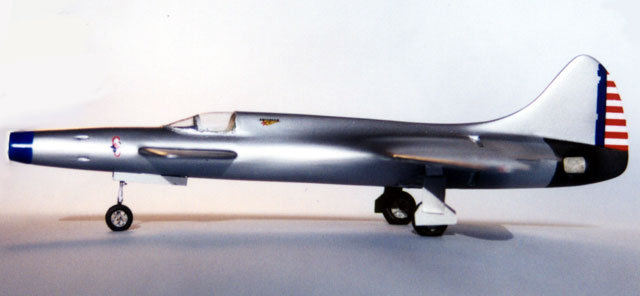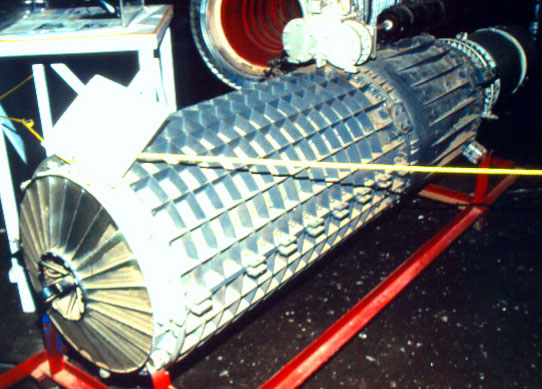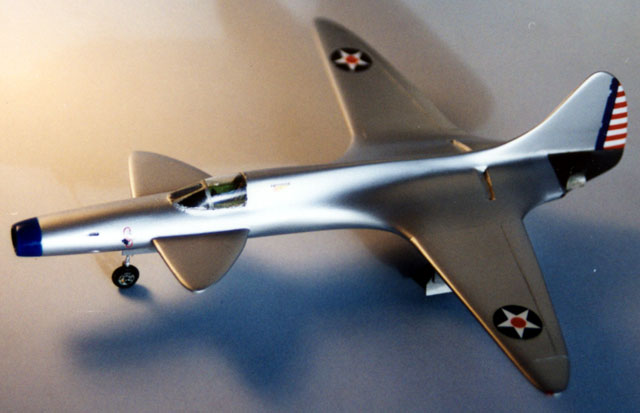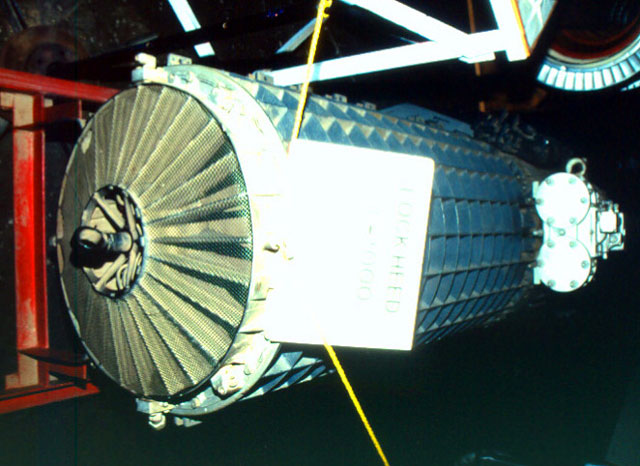|
Lockheed L-133
by Tom Conte
|
 |
|
Lockheed L-133 |

HyperScale is proudly supported by
Squadron
Towards the end of 1940, the Lockheed Aircraft Company believed that a
radical new approach was required to produce a fundamentally different
aircraft. The company wanted to build a fighter that had such an advantage
in speed and altitude that nothing made by any other country could touch.
Among their many talented engineers was Nathan Price, a designer that
developed a steam turbine driving a propeller that powered and flew a
Travelair Biplane in 1933 before he started working at Lockheed. He
continued to develop the concept that eventually led to a gas-turbine
jet-propulsion engine. More people were added to the job of working out
the details of this engine and of course an airframe to put it in. Finally
a formal proposal was made to the Army Air Corp in February 1942.
It described a Mach 0.94 aircraft capable of flying at 50,000 ft. The
L-133 was to be a canard single seater aircraft powered by two of the
L-1000 axial-flow engine. It length was to be 48 ft. and 4 in. and a span
of 46 ft. 8 in. Armament was planned to be four 20 mm cannons concentrated
in the nose. Besides it speed other unique concepts were boundary-layer
control and reaction thrust roll control. Rather than be impressed the Air
Corp. was nearly horrified. It told Lockheed to stop wasting time and to
build more P-38 Lightings. At this time period and because of their lack
of experience, the American military planners were still thinking that
defending aircraft would be fighting incoming bombers at 10,000 feet and
need not to go much faster than 400 mph. Lockheed was unaware at the time
that the Air Corp. knew about the progress of other turbine engines and
was trying to control the overall development of this type of engine in
the US. In fact, H.P Hibbard, Lockheed V.P. of engineering, only gave the
go ahead for this project because he felt that his company would be alone
with this 600 mph class of aircraft.

While the L-133 aircraft was never built, the L-1000 engine was. It was
one of the most powerful and efficient engines of its time. Construction
was started during the war, but Lockheed gave up on its development
testing and permitted the Menasco Engine Manufacturing Co. to continue
with it so it could concentrate on other projects. It turned out to be a
handful for Menasco and the XJ-37 as it was now called wound up at Wright
Aeronautical Corp. for testing until nearly 1950. The engine finally came
to rest in a corner of Chino's Planes of Fame museum in California. Back
in 1993 while I was wandering around a hanger I came across what appeared
to be a large waffle wrapped around a sewer pipe under and behind another
display. When I realized this dusty relic’s important position in the
early history of jet aircraft, I was inspired to learn more about the
engine and aircraft, which resulted in a model.
Although the L-133 aircraft was not built does not mean it never
contributed to the wealth of aeronautical information. If one notices, it
has the same wing outline as the P-80 Shooting Star Lockheed did build a
few years later. One reason that the P-80 was able to be constructed and
flown so quickly was because the engineers could draw from their previous
work on the L-133.
|
Building the L-133 in 1/72 Scale |
After creating working drawings and reducing them to 1/72 scale I began
making the model. One area on the model that differs from available
information is that I made the cockpit wider. Most drawings show it as
being very narrow which would resulted in the full-size aircraft having
little room for the pilot and poor visibility, I made this area just as
big as the P-38’s. The L-133 is nearly the same wingspan as the P-38 and I
could have used a set of wing from a kit, but I decided to use styrene
sheet because it would have taken as long to convert a set of wings as it
would to scratch build one. The canard and vertical stabilizer are also
made from plastic.

The fuselage was made from balsa wood which took a lot of filler to
obtain a smooth finish. Some modelers may recognize this model as the one
I had in a medium green and light gray camouflage finish. It’s the same
one. Over the years the wood sealer had cracked and the model needed a new
paint job. This is why I have been searching for and found new materials
to scratchbuild in, to avoid this problem. Since this aircraft was so
similar in size to the P-38 I used True Detail’s wheel set for the P-38
for the landing gear and other detailing parts for a Lighting to detail
out the cockpit.
After sanding down the model and applying an automotive type of sealer, I
decided in the more colorful prewar finish because early patent drawings
by Lockheed shows similar aircraft in that scheme, and most of the
drawings of the L-133 were completed before America’s entry in the war,
and just because I felt it would look “cool”.
The aluminum finish was obtained by using Alcad paint available from
Squadron. This created a nice hard surface that could be masked and
polished. The Lockheed winged star company logo was created on the
computer and using a regular ink jet printer, printed on a clear decal
sheet that came with the SuperCal decalling systems made by Micro Format
Inc., USA. This was a simple way to create unique decals, there was no
smearing of the image while it was being printed or when the clear coat
was sprayed on. The water slide type of decal is only 5 mm long and you
can see a lot of detail in it. The “Hat in the Ring” squadron symbol came
from an old commercially produced sheet and is of the 94th Fighter
Squadron that was based in the US when WW II broke out and is still flying
today.
This aircraft, if it were built, would have had no problems in
maintaining the Allied air superiority over anything, anytime or anywhere
during WWII. As history has shown though, the conservative thinking of
managing the available material and talent resources to produced large
numbers of piston powered aircraft was the right choice.
Model by Tom Conte.
Photos of the L-1000 engine were taken for
me by fellow hobbyist Fred Cronenwett. When I saw the old rundown
condition of the outside of the hanger, I could not believe there was
anything important inside and did not bring a camera!

Luckily, I met Fred inside who was kind
enough to shoot some photos for me.
Text, Images and Model Copyright © 2002 by
Tom Conte
Page Created 24 February, 2002
Last Updated
04 June, 2007
Back to HyperScale Main Page
Back to Features Index |
Home
| What's New |
Features |
Gallery |
Reviews |
Reference |
Forum |
Search